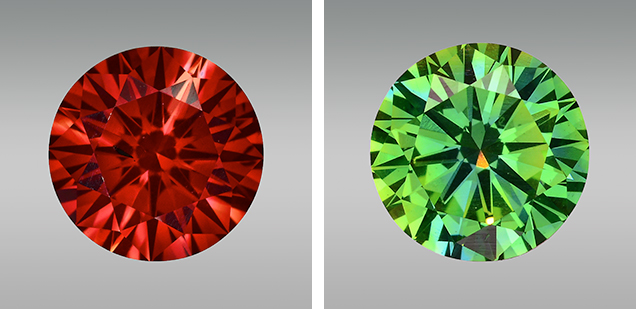Treated Red and Green HPHT Synthetic Diamonds

Natural-color red and green diamonds are extremely rare and command some of the highest prices in the market. Only a small number of natural diamonds have ever been graded as Fancy red without any modifying hues such as brownish red or orangy red. A 0.57 ct round brilliant with Fancy red color (figure 1, left) was recently submitted to GIA’s New York laboratory for a colored diamond grading report. It showed a heavily saturated and pure red color, without any modifications to the red hue. From another client, we received a 0.50 ct round brilliant graded as Fancy Vivid yellowish green (figure 1, right) for a synthetic colored diamond grading report. The striking features shared by these two specimens caught our attention.
Examination with a standard gemological microscope revealed that both of them contained pinpoint clouds and metallic inclusions (figure 2), a typical feature of synthetic diamonds grown by high pressure and high temperature (HPHT). Mid-FTIR absorption spectra identified both as type Ib, with the relatively high concentration of isolated nitrogen that is responsible for the yellow to brown color typically observed in HPHT synthetics (Winter 2015 Lab Notes, pp. 430–431).

The strong short-wave UV radiation of the DiamondView (figure 3) showed red and yellowish green fluorescence in the red and green samples, respectively. Furthermore, the presence of both cubic {100} and octahedral {111} growth sectors in the DiamondView images suggested that the specimens formed with a relatively high growth rate that facilitated cubic and octahedral development simultaneously, a strong indicator of synthetic origin (Winter 2015 Lab Notes, pp. 429–430).

Diffused lighting showed uneven color zoning in both samples, consisting of their bodycolors and the yellow color from the isolated nitrogen content (figure 4). Spectroscopic analysis revealed that the Fancy red synthetic had an unusually strong peak at 637 nm (NV– center). This peak indicates color alteration by post-growth annealing (T.W. Overton and J.E. Shigley, “A history of diamond treatments,” Spring 2008 G&G, pp. 33–55). In the Fancy Vivid yellowish green synthetic, a concentration of green color on the culet area indicates that artificial irradiation was applied to alter the as-grown yellow color to vivid green. Both synthetic diamonds underwent post-growth treatment to change their color to the desirable red and yellowish green hues. While the yellowish green round brilliant received a synthetic colored diamond report, the undisclosed nature of the Fancy red’s growth required the lab to issue an identification report to properly disclose its synthetic origin.




